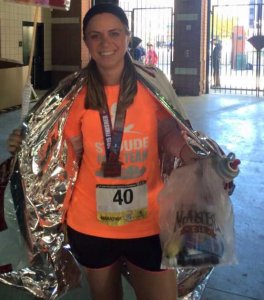Training to Run a Marathon: A Metaphor for Recovery

Those with eating disorders at risk for substance abuse
As a young person, Angela Quadrani struggled with bulimia nervosa – bingeing and purging.
“I liked that because I could physically control what was going in and going out,” Quadrani explains.
The purging aspect of bulimia means that those afflicted tend to exhibit a “normal” body weight, especially when compared to the wraith-like stereotype we associate with anorexia nervosa. This lets the problem go largely undetected. For Quadrani, busy with growing pains, anger issues, and family tensions, the purging thing wasn’t a problem.
For an individual who struggles with body image, their mirror can be a source of endless self-shaming, self-loathing, and guilt.
Quadrani experienced all of the above. And though she didn’t put two and two together at the time, she was soon solving the image problem with alcohol.
The treatment of eating disorders typically focuses on the idea of developing a healthy relationship with food. Some easy access points include nutrition, fitness, and personal care. Self-care is not always obvious to someone vulnerable to the societal judgment in epithets like “self-indulgent,” “lazy,” or “out of control.” Many who binge eat in solitude, whether or not they purge, have internalized these negative labels. They see themselves as lazy or out of control and expect they are not strict enough or tough enough on themselves. All this thinking does is add another layer of stress to the problem. Stress can lead to eating, and a vicious cycle begins.
Getting values of self-nourishment and self-care to resonate can take time and practice. It’s always easier to focus on losing weight, shrinking that number; becoming thinner, shrinking that dress or belt size. It’s also easier to believe that one’s character is rooted in size or that one’s emotional pain is caused by size. When someone abstains from eating or purges regularly, any number of similar beliefs can be in the mix.
But it’s not that these sufferers are lazy. They take on all kinds of draconian measures and practices. But following misguided messages from the environment will only lead to self-defeating measures. Starvation, purging, diet pills, pain meds…So like an estimated 25% of those struggling with bulimia (Bulik CM, et al), Quadrani soon developed a problem with alcohol. While drinking threw her personal life into a state of havoc, it also derailed her college career path. Finally, it got her to take action and begin 12-Step meetings.
But Quadrani was lucky. She also found running.
Running – One Person’s Key To “Loving Life” in Recovery

“The running thing just kind of took a life of its own,” Quadrani recalls.
“I met people who were running. I built a community of friends around running. I found a sense of peace about it all. You’re out there in the middle of the woods, it’s so peaceful, it’s like a bonding moment with God – I got a dog, named Reese, who would come running with me. “
By the time she found running, Angela had already gotten clean and sober and had been working her recovery one day at a time, but something was missing. It took her a while, and almost a relapse, to realize that she still had a problem.
“Three years sober is when I got honest with myself about the eating disorder. I was still in denial. I had found binge-purging a coping mechanism. Even though I knew I probably shouldn’t be doing it, I didn’t realize I was using it as a coping mechanism.”
What she instinctively knew, that her eating patterns could impact her sobriety, is born out by science. Hormonal studies show a chemical connection. The numbers show that roughly a quarter of those struggling with addiction began on that path by turning to a substance to self-medicate or reduce stress.
As recovery lost its sheen for Quadrani, tension grew around the negative body images staring back at her from the mirror, and it began to impact her mood. As she recalls it,
“It didn’t get brought to my attention until I realized I had been doing it for days, binge-purging, isolating, feeling really low about myself, worthlessness, I don’t want to be here, I don’t feel really good about my body. I knew I would go back to drinking.”
Quadrani knew about coping mechanisms, but she needed help seeing the connection between binge/purging and drinking, and she was fortunate to recognize the issue as something she not could handle alone. She wisely turned to mentorship and outside help.
“I sought direction from a dietician followed by 4 months intensive individual therapy with a therapist for my Eating Disorder.”
At American Addiction Centers’ treatment facilities, a lot of importance is placed on instilling habits of fresh, healthy nutrition and physical fitness.
Ensuring meals with balanced nutrition is more than an amenity – it’s a deliberate treatment component.
Ever more research shows the positive benefits of exercise and fitness on basic bio-systems – to reduce cortisol levels and inflammation, to improve fatty liver and insulin sensitivity, to therefore strengthen the immune system and reduce disease.
In choosing sobriety, Quadrani learned more about self-care and how fitness, food and nutrition are woven together to impact mood. She found ways to embrace a healthy lifestyle; she began studying nutrition. Soon she received her Bachelor’s degree in Nutrition and Dietetics at Ole Miss. She is now a Registered Dietetic Tech. When Quadrani found running, it quickly grew into a way of life.Once that happened, she didn’t look back.
These days, she is not just a runner, but an ultra runner with over ten marathons under her belt, and a running resume that includes races of 60 miles or more. Her power and endurance in running allowed her to qualify as a “pacer” for St. Jude’s Memphis Marathon on Saturday, December 3.
When she runs the 26.2 miles in Memphis, she will not only be a qualified “pacer,” but she will be a St. Jude’s “Hero.” This means that she will be fundraising for the children of St. Jude’s and the childhood disease research – for cancer and other life-threatening illnesses – that goes on at this important hospital. According to Quadrani, in the final leg of the race the children of St. Jude’s gather at the finish line to dole out high-fives and encouragement, such as, “you can do it!”
Training to Run a Marathon: A Metaphor for Recovery
With those exuberant hi-fives in mind, Quadrani and more than twenty thousand other runners from all around the globe will line up to run for children like Yamila, a ten-year-old girl who’s been fighting leukemia since the age of 3, and Cedric, a 10-year-old lover of basketball diagnosed at birth with sickle cell disease. Dealing with the painful ups and downs of life-threatening diseases, parents and families the world over travel to Memphis, TN, to give their children the chance that only St. Jude’s provides.
Started by comedian Danny Thomas, St. Jude’s Hospital was the first of its kind to combine research and treatment in one location. Thomas conceived the hospital with a unique mission that his three children, Marlo, Terre, and Tony, carry on to this day: “No child will be turned away because of a family’s inability to pay.”
Following the stories of children like Cedric and Yamila reveals tremendous crests and troughs of emotion; it’s a path of small victories and large defeats, of great strength, of dogged perseverance, and of kind, committed support. St. Jude’s researchers liken their research in the multivariate, stubborn, and perplexing disease of cancer to a marathon.
Celebrating its 15th year, St. Jude Memphis Marathon provides runners with an apt metaphor for understanding the struggles, determination, and ultimate feeling of victory for those who finish.
As a treatment consultant for American Addiction Centers, Quadrani also likens the marathon to recovery. Overcoming the most grueling stretches brings rewarding lessons. Quadrani finally feels that all of her endeavors are working together for good. “They all kind of go hand in hand – recovery and running.”
Service and Metaphors
Many in recovery know how deep the lows can go. But those same lows may take someone new in recovery by surprise – perhaps they bought into the myth that gaining sobriety will make everything good again. Like the option to drop out of a grueling race, relapse is always tempting. Endurance training has taught Quadrani about pushing through the emotional triggers that make giving up so alluring.
“There are moments you go so low, you wonder ‘why the heck would I sign up for this’ – it’s a metaphor for recovery for me.”
She talks about earlier days in recovery when she would wake up to a barrage of negative thoughts. Or she would look in the mirror and begin to hate the image looking back. Likewise, training for a very long race is fraught with doubt and discomfort, even fear. In the bleakest moment, there’s no knowing how long the blue mood or the sense of desperation will last.
“It could be 30 seconds, before you go, “oh I’m a badass!” Quadrani says. “Sometimes it’s hours.”
Basically, she learned there is a payoff – just not always made to order. By not giving up on long distance training, Quadrani gained a sense of what it means to “go into” a problem or negative mood and explore it more deeply. She calls her shift in perspective as “running though your problems rather than running away from them.” Her former self may have sought to avoid the same challenges by turning to alcohol.
Running has helped Angela clear space to be more self-aware, and with that, she has also accumulated the courage to examine strategies she once used to use to avoid emotional pain.
“When I was angry, I would fight my family physically, and I had this outrage; it was overwhelming – I’ll show you; I’ll kill me – What I would do in the past was I would give up, or I would do something tragic, throw the punch.”
Running feeds Recovery

Along with presence, self-awareness, and appreciation for quiet solitude, distance running has given Quadrani a way to look at life.
“If I was out there running and I start to think negative about my life – it’s my only time away from people or things – and then running through it, taking all that energy and then letting it go – and talk to God while doing it. All that aggression (I was an angry person!), I got through by running.” – Angela Quadrani
Watching her body perform against obstacles and time, Angela gains insight that she can use to strengthen her recovery. For example, she can catch negative thinking and apply learned strategies to interrupt the pattern.
“I notice when I start to slow down, I’m usually thinking something negative.”
She tells herself, “’You’re going to do something about it,’ like, ‘You’re on a mission.’”
Quadrani adds, “It also helps to have a runner’s high – after a few miles your endorphins are kicking in.”
Beginning runners may want to note that Quadrani estimates it takes her a good 8 – 10 miles of running before the endorphin payoff that everyone talks about.
In treatment at AAC, most people learn about the self-healing power of the human body, when we assist with healthy habits and then get out of the way. They also learn that self-care is not selfish; it’s part of recovery. But bringing these observations into one’s lifestyle, so they become dependable friends of recovery, is a hard-won transfer, kind of like finishing a marathon. Through running over time, Quadrani has come to appreciate her body.
“Your body is a machine, feeding it, watering it, the body is incredible.”
Quadrani passes her positivity on to the many people who come to recovery wanting to get healthy again. Like St. Jude’s children offering their the finish-line encouragement, Quadrani assures people who long for recovery that “they can do it!” but with one caveat – take it slow and steady.
“They put all these big goals on themselves,” Quadrani warns. “If you want to lose the weight you put on, there’s no dream that’s too big – one day at a time. All of those little steps will add up to something big.”
This December 3 at the Memphis Marathon, Quadrani tackles something big, as a runner, a pacer, and a Hero, for the children of St. Jude’s Hospital.
